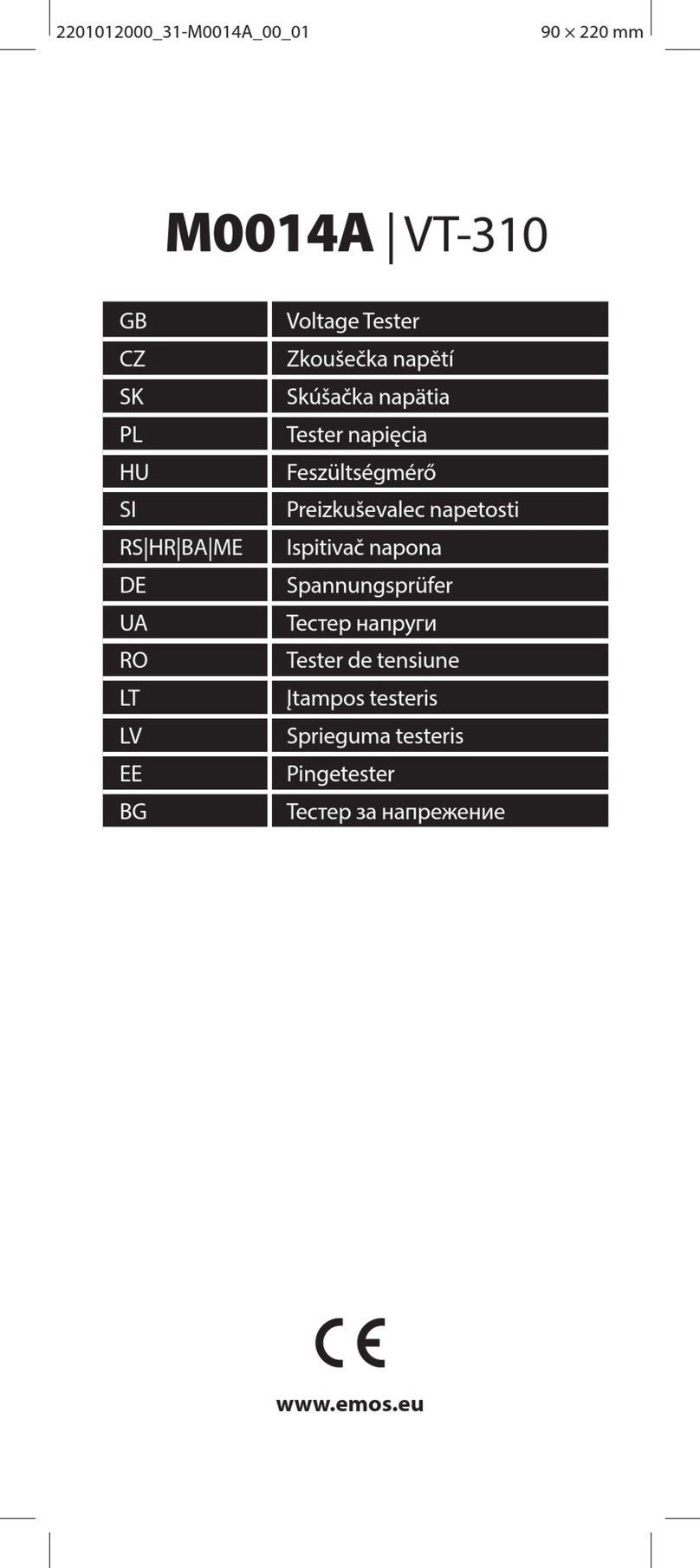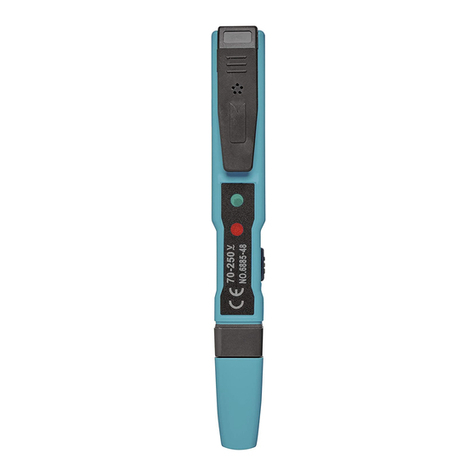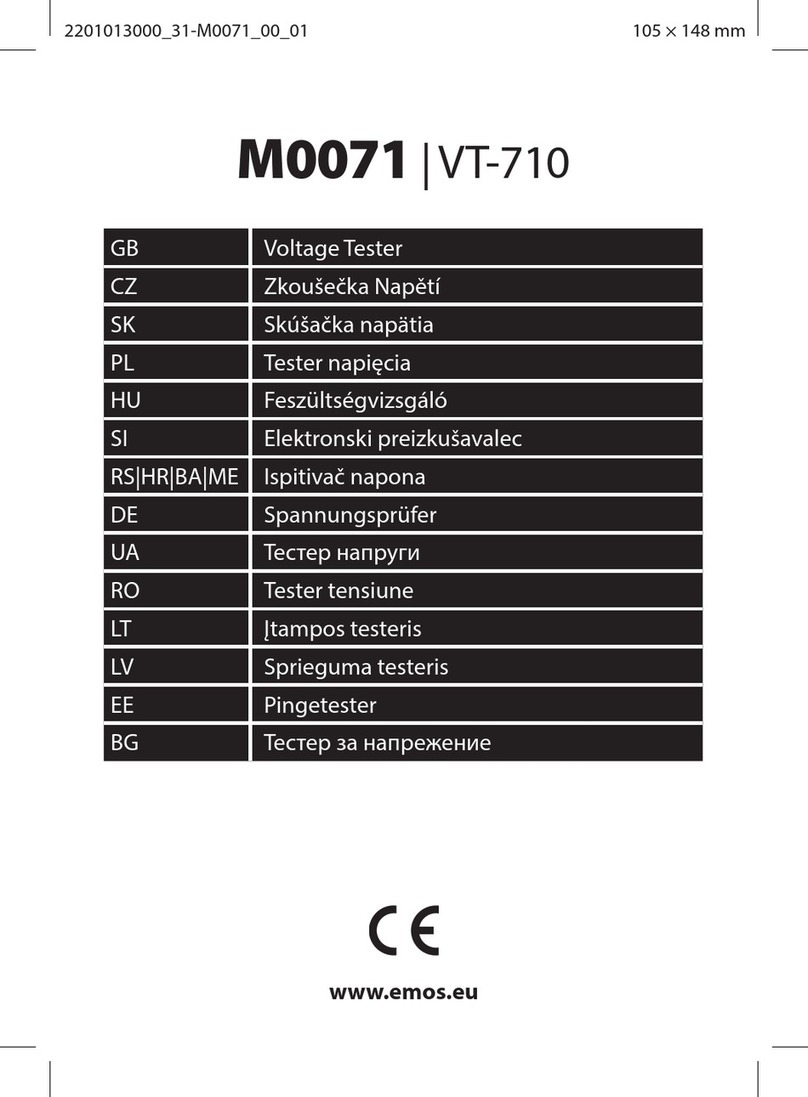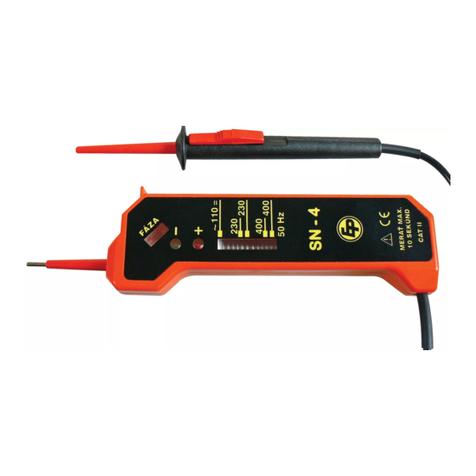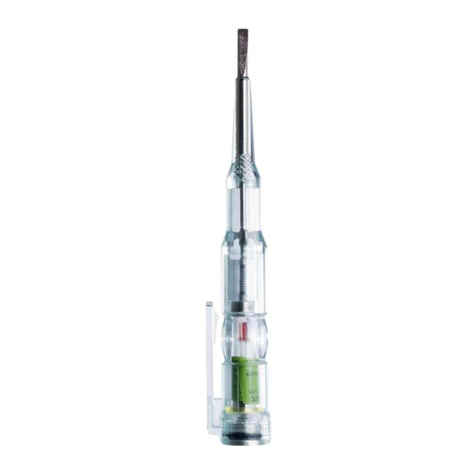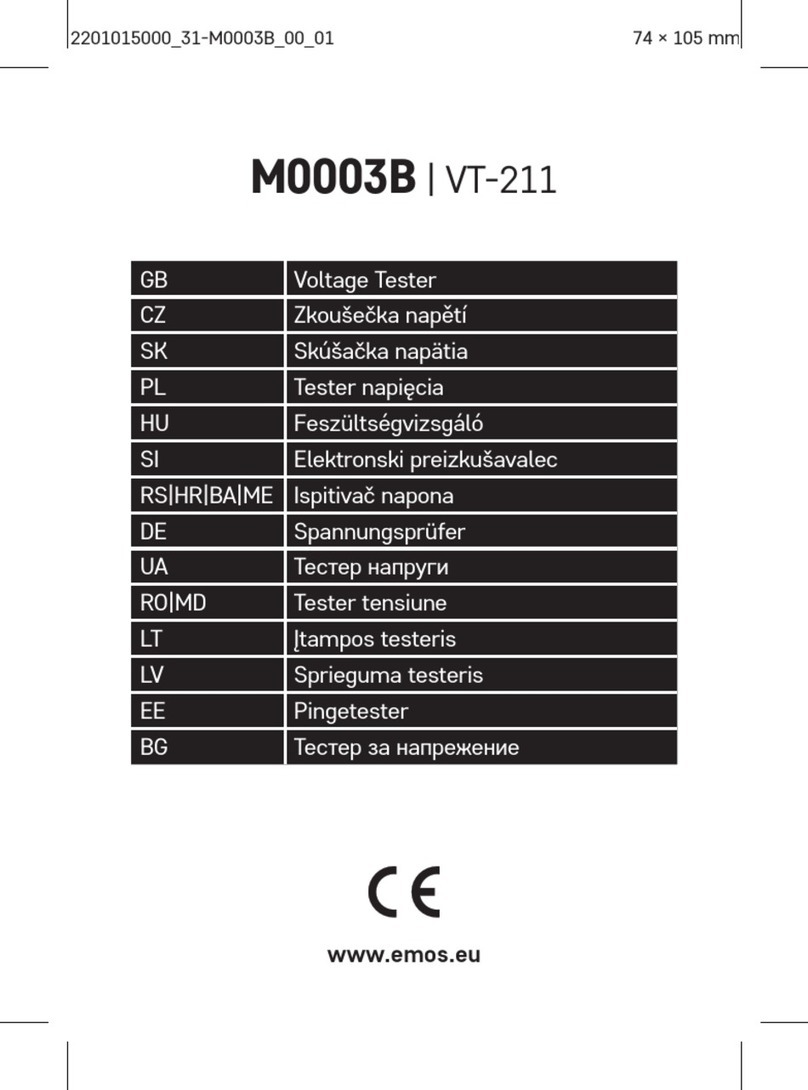Emos VT-320 User manual

2201014000_31-M0012A_00_01 90 × 220 mm
www.emos.eu
M0012A | VT-320
GB Voltage Tester
CZ Zkoušečka napětí
SK Skúšačka napätia
PL Tester napięcia
HU Feszültségmérő
SI Preizkuševalec napetosti
RS|HR|BA|ME Ispitivač napona
DE Spannungsprüfer
UA Тестер напруги
RO Tester de tensiune
LT Įtampos testeris
LV Sprieguma testeris
EE Pingetester
BG Тестер за напрежение

2
GB | Voltage Tester
Voltage tester VT-320 is designed for two-pole measurement of DC and AC voltage
between 12 and 690 V with a frequency of 0–60 Hz, for identifying the phase conductor,
the phase sequence in a three-phase system with a neutral conductor, to determine the
polarity of DC voltage and test continuity.
The tester meets the requirements of standard EN 61243-3:2015.
The tester can be used for making measurements in electrical wiring and devices falling
within overvoltage category CAT III 690 V.
Category CAT III is designed for measuring circuits powered by a xed output power
supply, such as relays, sockets, switchboards, power supplies, short branching circuits
and lighting systems in large buildings.
Do not use for higher CAT categories.
International Electrical Symbols
alternating current (AC)
direct current (DC)
alternating or direct current
earthing
double insulation
warning, risk of danger. Read the manual in all cases where this symbol is used!
risk of injury by electric current
declaration of conformity (CE)
Specications
Pollution degree: 2
Category and measurement range: CAT III 12–690 V AC/DC
Operating temperature: -10 °C to 55 °C
Storage temperature: -20 °C to 55 °C
Power supply: 1× 9 V battery, type 6F22
Enclosure: IP54
Dimensions 27 × 50 × 200 mm
Weight: 157 g (battery included)
Description of Tester
(see g. 1)
1 – Mobile measuring tip
2 – Mobile measuring tip barrier
3 – Slider
4 – LEDs of voltage volume and +/-
polarity
5 – L2 measuring tip
6 – L3 LED
7 – Measuring tip barrier
8 – R LED
9 – R button
R
690
400400
230
120
50
24
R
L1
L2
L3
12
+
1
2
34
10
11
5
6
7
12
9
8
1
2

3
10 – Metal protrusion
11 – Battery compartment
12 – Tester lug
When measuring with the mobile measuring tip, you must move the slider down to
expose the metal tip; see gure 2.
Verifying Tester Functionality
Verify the tester’s functionality before use.
Verify using power sources with known parameters.
• Short-circuit the measuring tips and press the R button; a buzzer will sound and
the R LED will light up.
• Insert tip L2 into the phase hole of a 230 V AC power socket and touch the metal pro-
trusion on the back of the tester. The red L3 LED will light up and a buzzer will sound.
• Connect the tester to both holes in a socket (230 V AC); +/-, R and L3 LEDs will light
up, the column of LEDs will light up all the way up to 230 V and a buzzer will sound.
AC Voltage Value Indication
Place both measuring tips onto the measured object (circuit).
The voltage value will be displayed on the LED scale and the +/- , R and L3 LEDs will
light up.
You will hear a buzzer (at over 50 V) and an LED will be lit up.
Note: If the battery is not inserted, the buzzer will not be functional.
DC Voltage Value Indication
Place both measuring tips onto the measured object (circuit).
The voltage value will appear on the LED scale.
You will hear a buzzer (at over 50 V) and an LED will be lit up.
If tip L2 is on the positive pole, the + LED will be lit up.
If tip L2 is on the negative pole, the + LED will be lit up.
Note: If the battery is not inserted, the buzzer will not be functional.
Identifying the Phase Conductor
Place the mobile measuring tip or L2 tip onto the phase conductor.
Place a nger on the metal protrusion on the back of the tester.
If phase voltage is higher than 50 V, you will hear a buzzer and the L3 LED will light up.
Note:
If the battery is not inserted, phase detection will not be functional.
Before measuring, run a test on a dierent, known phase conductor.
After measuring, test the circuit again using both tips.
The measurement results may be negatively aected by electrostatic elds, level of insu-
lation, etc.
Determining Phase Sequence
Place a nger on the metal protrusion on the back of the tester.
Place the xed measuring tip L2 onto the central terminal of the three-phase system.
Place the mobile measuring tip onto the left terminal.
If the two phases are in the correct order, diodes 12 to 230 V will be lit up and diode
L3 with turn o.
If the two phases are not in the correct order, diode L3 will remain lit.
Note:
Phase sequence detection is functional at voltages higher than 110 V AC.
Before measuring, run a test measurement on a dierent, known three-phase source.
When measuring, make sure the tips are in solid contact with the measured source.
Measuring Circuit Continuity
Place both tips of the tester onto the measured object.
Press the R button.
If resistance of the measured circuit is <400 kΩ, the tester will evaluate that as circuit
continuity, a buzzer will sound and the R LED will light up.
If resistance in the measured circuit is >400 kΩ but lower than 1 MΩ, the R LED will light
up, but the buzzer will not activate.
At resistance between >1 MΩ and 10 MΩ, the R LED will light up slightly, and the buzzer
will not activate.
At resistance of >10 MΩ, the tester will not turn on at all!
Battery Replacement
Replace the battery in the tester if the buzzer does not activate or the LED does not light
up when you short-circuit the two tips together.
Disconnect the tester from all voltage sources.
Remove the battery cover screws using a suitable screwdriver and remove the cover.
Remove the drained battery.
Insert a new 9 V alkaline battery, type 6F22, and make sure to observe correct polarity
of contacts; do not use a rechargeable battery.
Replace the cover and screw it back on.
WARNING
• Do not use the device if the leads or cover are damaged.
• The device may only be operated by a responsible and trained person.
• Do not test voltage through contact if you do not know the exact voltage in the
circuit!
• ATTENTION! The measurement time must not be longer than 10 seconds, especially
in higher voltages.
• The maximum measurement time must not exceed 30 seconds or the device will
become damaged.
• A pause of 240 seconds must follow after each measurement.

4
• When measuring, hold the probe by the mechanical guard on the tester body. This
will prevent accidental contact with the metal portion of the probe, which could
otherwise cause injury by electric current during measurement.
• The voltage listed on the tester is nominal voltage. The tester may only be used in
installations with the listed nominal voltage.
• The tester can only be used for testing voltages above the ELV threshold (Extra
low voltage).
• The tester must be checked before and after testing. If the indicators on the tester
are failing, the tester must not be used.
• In case of usage on higher voltage than prescribed, the tester may become damaged.
• Do not modify the measuring tips or any other parts of the tester. If the tester is
malfunctioning or otherwise damaged, have it repaired in a professional repair shop.
• Do not use the tester if its components are wet.
Maintenance
The tester is designed to require no service on any of its components and is mainte-
nance-free.
Cleaning
• Occasionally wipe the tester with a soft moistened cloth and common home deter-
gent. Do not use aggressive solvents.
• Prevent ingress of water into the interior of the device to protect the device against
short circuits and other types of damage.
This device is not intended for use by persons (including children) whose physical,
sensory or mental disability or lack of experience and expertise prevents safe use, unless
they are supervised or instructed in the use of the appliance by a person responsible for
their safety. Children must always be supervised and must never play with the device.
A declaration of conformity has been issued for this product.
Do not dispose with domestic waste. Use special collection points for sorted waste.
Contact local authorities for information about collection points. If the electronic
devices would be disposed on landll, dangerous substances may reach ground-
water and subsequently food chain, where it could aect human health.
CZ | Zkoušečka napětí
Zkoušečka VT-320 je určená ke dvojpólovému měření velikosti stejnosměrného a stří-
davého napětí od 12 V do 690 V s frekvencí 0–60 Hz, k určení fázového vodiče, pořadí
fází trojfázové soustavy s nulovým vodičem, určení polarity stejnosměrného napětí,
testování kontinuity.
Zkoušečka vyhovuje normě EN 61243-3:2015.
S touto zkoušečkou můžete provádět měření v elektrických instalacích a zařízeních, které
odpovídají přepěťové kategorii CAT III 690 V.
Kategorie CAT III je určena k měření obvodů z vybavení napájeného pevnou instalací;
jako relé, zásuvky, rozvodné panely, napáječe a krátké větvící obvody a osvětlovací
systémy ve velkých budovách.
Nepoužívejte pro vyšší kategorie CAT.
Mezinárodní elektrické symboly
střídavý proud (AC)
stejnosměrný proud (DC)
střídavý nebo stejnosměrný proud
uzemnění
dvojitá izolace
výstraha, riziko nebezpečí. Prostudujte tento návod ve všech případech, kde je tato
značka použita!
nebezpečí úrazu elektrickým proudem
prohlášení o shodě (CE)
Technické parametry
Stupeň znečištění: 2
Kategorie a rozsah měření: CAT III 12–690 V AC/DC
Pracovní teplota: -10 °C až 55 °C
Skladovací teplota: -20 °C až 55 °C
Napájení: 1× 9 V baterie, typ 6F22
Stupeň krytí: IP54
Rozměry 27 × 50 × 200 mm
Hmotnost: 157 g (přiložena baterie)
Popis zkoušečky
(viz obr. 1)
1 – Pohyblivý měřící hrot
2 – Zábrana pohyblivého měřícího
hrotu
3 – Posuvník
4 – LED diody velikosti napětí a
polarity +/-
5 – Měřící hrot zkoušečky L2
6 – LED dioda L3
7 – Zábrana měřícího hrotu
8 – LED dioda R
9 – Tlačítko R
10 – Kovový výstupek
11 – Bateriový prostor
12 – Příchytka zkoušečky
U pohyblivého měřícího hrotu je vždy nutné zmáčknout posuvník směrem dolů, aby
došlo k vysunutí kovové špičky hrotu, viz obrázek 2.

5
Ověření funkčnosti zkoušečky
Před použitím zkontrolujte funkčnost zkoušečky.
Pro ověření funkčnosti používejte zdroje, jejichž parametry dobře znáte.
• Zkratujte měřící hroty a stlačte tlačítko R, ozve se bzučák a rozsvítí se LED R.
• Vložte hrot L2 do fázové zdířky zásuvky 230 V AC a dotkněte se kovového výstupku
na zadní straně zkoušečky. Rozsvítí se červená LED L3 a ozve se bzučák.
• Připojte zkoušečku do obou zdířek zásuvky (230 V AC), rozsvítí se +/-, R a L3 LED,
sloupec LED diod až po 230 V a ozve se bzučák.
Indikace velikosti AC napětí
Přiložte oba měřící hroty k měřenému objektu (obvodu).
Hodnota napětí se zobrazí na LED stupnici a bude svítit +/-, R a L3 LED.
Zazní bzučák (nad 50 V) a LED bude svítit.
Poznámka: Pokud není vložena baterie, nebude bzučák funkční.
Indikace velikosti DC napětí
Přiložte oba měřící hroty k měřenému objektu (obvodu).
Hodnota napětí se zobrazí na LED stupnici.
Zazní bzučák (nad 50 V) a LED bude svítit.
Pokud bude na hrotu L2 kladný pól, bude svítit + LED.
Pokud bude na hrotu L2 záporný pól, bude svítit - LED.
Poznámka: Pokud není vložena baterie, nebude bzučák funkční.
Určovaní fázového vodiče
Přiložte pohyblivý měřicí hrot nebo L2 hrot na fázový vodič.
Přiložte prst na kovový výstupek na zadní straně zkoušečky.
Při výskytu fázového napětí vyšším než 50 V zazní bzučák a L3 LED bude svítit.
Poznámka:
Pokud není vložená baterie, nebude detekce fáze funkční.
Před měřením proveďte test na jiném ověřeném fázovém vodiči.
Po měření otestujte obvod znovu pomocí obou hrotů.
Výsledek měření může být negativně ovlivněn elektrostatickým polem, úrovní izolace apod.
Zjišťování pořadí fází
Přiložte prst na kovový výstupek na zadní straně zkoušečky.
Pevný měřicí hrot L2 přiložte na střední svorku trojfázové soustavy.
Pohyblivý měřicí hrot přiložte na svorku vlevo.
Jestli jsou tyto dvě fáze ve správném pořadí, budou svítit diody 12 až 230 V a L3 dioda
zhasne.
Pokud nejsou tyto dvě fáze ve správném pořadí, zůstane L3 dioda svítit.
Poznámka:
Funkce zjištění pořadí fází je funkční při napětí vyšším než 110 V AC.
Před měřením otestujte na jiném ověřeném třífázovém zdroji.
Při měření dbejte na to, aby hroty měly vždy dobrý kontakt s měřeným zdrojem.
Měření spojitosti obvodu
Přiložte oba hroty zkoušečky přiložte na měřený objekt.
Stiskněte tlačítko R.
Je-li odpor měřeného obvodu <400 kΩ, zkoušečka to vyhodnotí jako spojitost, ozve se
bzučák a rozsvítí se LED dioda R.
Je-li odpor měřeného obvodu >400 kΩ ale menší než 1 MΩ, rozsvítí se LED dioda R, ale
bzučák nezazní.
Při odporu mezi >1 MΩ až 10 MΩ se slabě rozsvítí LED dioda R, bzučák nezazní.
Při odporu >10 MΩ se zkoušečka vůbec nezapne!
Výměna baterie
Vyměňte baterii ve zkoušečce pokud:
Když nezazní bzučák nebo se nerozsvítí LED, když zkratujete vzájemně oba hroty.
Odpojte zkoušečku od zdroje napětí.
Odšroubujte šroubky bateriového krytu vhodným šroubovákem a sundejte kryt.
Vyjměte vybitou baterii.
Vložte novou alkalickou baterii 9 V typ 6F22, dbejte na správnou polaritu kontaktů;
nepoužívejte nabíjecí baterii.
Nasaďte a zašroubujte zpět bateriový kryt.
VAROVÁNÍ
• Nepoužívejte přístroj s poškozeným kabelem nebo krytem.
• Tento přístroj může být obsluhován pouze odpovědnou a proškolenou osobou.
• Nezjišťujte zkoušečkou napětí kontaktně, pokud neznáte jeho přesnou velikost!
• POZOR! Délka měření nesmí být delší než 10 sekund zvláště u vyššího napětí.
• Maximální doba měření však nesmí překročit 30 sekund, jinak dojde k poškození
přístroje.
• Po každém měření musí následovat prodleva 240 sekund.
• Při měření musíte sondu držet za zábranou na těle zkoušečky. Zabráníte tak
náhodnému dotyku s kovovou částí sondy, která při měření může způsobit úraz
elektrickým proudem.
• Napětí uvedené na zkoušečce je jmenovité napětí. Zkoušečku lze užívat jen v insta-
lacích s uvedeným jmenovitým napětím.
• Zkoušečkou se zjišťuje jen napětí nad mezí ELV (Extra low voltage).
• Zkoušečka musí být kontrolovaná před i po zkoušce. Pokud selhává indikace, nesmí
být používána.
• V případě použití na vyšší napětí, než je předepsané, může dojít k poškození
zkoušečky.
This manual suits for next models
1
Table of contents
Languages:
Other Emos Test Equipment manuals
Popular Test Equipment manuals by other brands

Redtech
Redtech TRAILERteck T05 user manual

Venmar
Venmar AVS Constructo 1.0 HRV user guide

Test Instrument Solutions
Test Instrument Solutions SafetyPAT operating manual

Hanna Instruments
Hanna Instruments HI 38078 instruction manual

Kistler
Kistler 5495C Series instruction manual

Waygate Technologies
Waygate Technologies DM5E Basic quick start guide

StoneL
StoneL DeviceNet CK464002A manual

Seica
Seica RAPID 220 Site preparation guide

Kingfisher
Kingfisher KI7400 Series Training manual

Kurth Electronic
Kurth Electronic CCTS-03 operating manual

SMART
SMART KANAAD SBT XTREME 3G Series user manual

Agilent Technologies
Agilent Technologies BERT Serial Getting started
